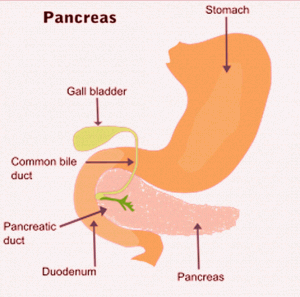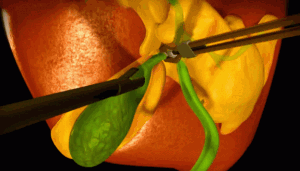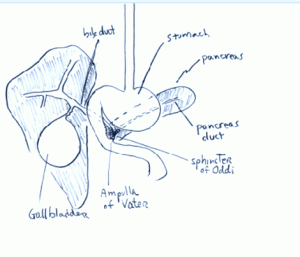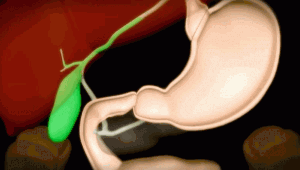The gallbladder is a hollow organ occurring just below the liver. In adults, its length is about 3.1 inches or 8cm, and measures about 1.6 inches or 4 cm in diameter, when completely distended. The gallbladder comprises of three parts, i.e. the fundus, body and neck. The neck shrinks and joins the biliary tree through the cystic duct, when then connects to the common hepatic duct to form the common bile duct.
A mucosal crease known as Hartmann’s pouch occurs at the neck of the gallbladder, where the gallstones usually become stuck. The gallbladder’s angle is situated between the coastal border and the lateral border of the rectus abdominis muscle.
When completely full, the gallbladder has the capacity to hold an estimated 50 mm of bile at once. The gland aids digestion, but is not a very vital organ as people can live without a gallbladder. However, its absence can affect the quality of life
Gallbladder function
The gallbladder performs two important functions, which are as follows:
- Storage of bile
- Concentration of bile
Bile is an essential ingredient in the digestive process. This liquid is composed of several anions of bile acids and is majorly produced by the liver. Bile helps in the stabilization of fats present in the food. The bile produced by the liver travels through many small bile ducts, which combine together to make a general hepatic duct. The fluid then goes to the gallbladder for storage and concentration, so that it can be used later. A hormone called CCK or cholecystokinin is released post consumption of fatty foods. This hormone causes the contraction of the gallbladder. At the same time it is also responsible for relaxation of a tiny valve present at the end of the hepatic duct. This facilitates the smooth passage of bile into the duodenum, where it combines with food for proper digestion. The reduction/disappearance of CCK causes the closure of the valve and the relaxation of the gallbladder. This process occurs repetitively.
The characteristics of bile salt anions are listed below:
- It mixes small amounts of triglycerides and phsopholipids to create ‘micelles’. It has the capacity to add these because of its hydrophobic and hydrophilic features.
- The micelles create space for allowing the pancreatic lipase enzyme to function. This enzyme aids the digestion of triglycerides
- The absence of bile salts will result in the elimination of food fats that do not dilate in water, along with the feces and without digestion.
Gallbladder pain and other problems
- The most common cause of gallbladder pain is the presence of gallstones. A majority of gallstones are composed of cholesterol, which is a normal constituent of bile. Since cholesterol is insoluble in water, other bile compounds like lecithin and bile acids perform the function of keeping the cholesterol in the liquid. An imbalance resulting from excess cholesterol or reduced bile acids can cause the cholesterol to become supersaturated, resulting in the development of tiny crystals and ultimately stones. It may be noted that estrogen elevates the cholesterol concentration in bile. Hence, women are more vulnerable to gallstones than men. It additionally explains its increased incidence in women using birth control pills, obese women and pregnant women.
- Occasionally a gallstone can obstruct the cystic duct leading to intense pain in the abdomen. This disorder is known as biliary colic, which leads to spasmodic pain that can persist for nearly two hours
- The gallbladder may sometimes become rigid and inflamed, which can also result in extreme gallbladder pain. Occurrence of gallstones can also lead to scarring, which can then cause chronic gallbladder disease, eventually resulting in a dysfunctional gallbladder.
- Another condition associated with the gallbladder is cholecystitis, which is caused due to an inflamed gallbladder. Such inflammation may result from intake of excess acidic food, alcoholism, infections, etc. These and other factors lead to accumulation of bile within the gland, causing irritation, which in turn leads to swelling of the gallbladder.
Gallbladder disease symptoms
Some of the signs and symptoms of gallbladder anomalies are as follows:
- Pain in the abdominal area, often post eating. Such pain can occasionally be very severe and radiate to the lower back area
- Children with gallbladder dysfunction may experience yellowing of the eye whites and the skin. One may also notice chalky colored feces
- Women with gallbladder problems may also report similar symptoms. Some may develop fever along with shaking chills. Other symptoms which are reported include vomiting, nausea, a feeling of stomach fullness even when it is empty and abdominal bloating.
- Gallbladder problem symptoms during pregnancy include heartburn, indigestion and gas. These signs are usually observed in the later trimesters, when the hormone levels in the body experience a sudden surge
- A swollen gallbladder can be felt on the right part of the abdomen. Tenderness and a dull pain may be experienced. This pain may exacerbate post meals or when changing positions while sleeping.
- Other symptoms of gallbladder abnormalities include abdominal pain when walking, coughing, etc., dark colored urine, constipation, discomfort and pain in the chest when breathing deeply, excessive and frequent burping and belching, and increased sweating
Causes of gallbladder problems
- A majority of the gallbladder problems are caused due to malfunction of the gallbladder, which is turn may result from gallbladder diseases. Reduced flow of bile, production of toxic bile by the liver, blockage of the bile duct, and infections of the layers within the gallbladder are probable causes of gallbladder diseases.
- A high cholesterol diet results in the crystallization of fats, which increase the risk to developing gallstones
- Hyperthyroidism is understood to be closely related with gallbladder anomalies. The thyroid problem can reduce the metabolic rate in an individual which adversely affects the digestion of fatty foods. This causes buildup of debris and its crystallization leading to formation of stones
- The backup of bile stored on the gallbladder can result in discomfort. Such bile may or may not have stones
- Some food allergies can also result in swelling, pain and other problems of the gallbladder
Treatment of gallbladder dysfunction
- Infections of the gallbladder may be treated with antibiotics
- Gallstones are treated by surgical removal of the gallbladder. As mentioned earlier, it is not a vital organ and people can continue to live without it. However, the absence of a gallbladder can put additional pressure on the liver to produce bile after the consumption of every meal, which can then lead to compromised liver functionality.
- Other gallbladder problems are treated as per the associated symptoms
Gallbladder Pictures


Gallbladder surgery

Gallbladder diagram

Hi, i feel that i saw you visited my site so i came to 搟go back the want?I am attempting to to find things to enhance my website!I assume its adequate to make use of a few of your concepts!!